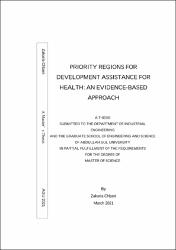PRIORITY REGIONS FOR DEVELOPMENT ASSISTANCE FOR HEALTH: AN EVIDENCE-BASED APPROACH
Abstract
Eligibility and allocation criteria of development assistance for health have received much attention in the last years. Critical issues have been raised on the usage of GNI per capita (GNIpc) as a sole indicator for this task. The major critics emphasize the GNIpc overlooks the changes in characteristics of middle-income countries (MICs). These countries now have the highest proportion of poor people and disease burden, combined with significant inequalities. Various alternative frameworks have been suggested that tried to avoid the issues GNIpc failed to take into account. This thesis attempts to build on previous works and introduce a data-driven methodology of developing a framework that guides eligibility and aid allocation decisions. The framework combines health status measures (estimating the level of wellness and illness of a population) and measures of capacity of response to the disease burden. We use Disability Adjusted Life Years (DALYs) as a measure of health status. To determine the measures of capacity, the starting point was to assemble relevant indicators in the literature. Using these indicators, feature selection then allowed to choose a minimal set of discriminative ones. Finally, an aggregate of chosen indicators enables ranking countries by order of priority. Comparing the framework with GNIpc and other frameworks show its potential usefulness. It is better than most other frameworks in targeting countries with a high disease burden and populations in extreme poverty. Moreover, it integrates some concerns other frameworks failed to address.


















